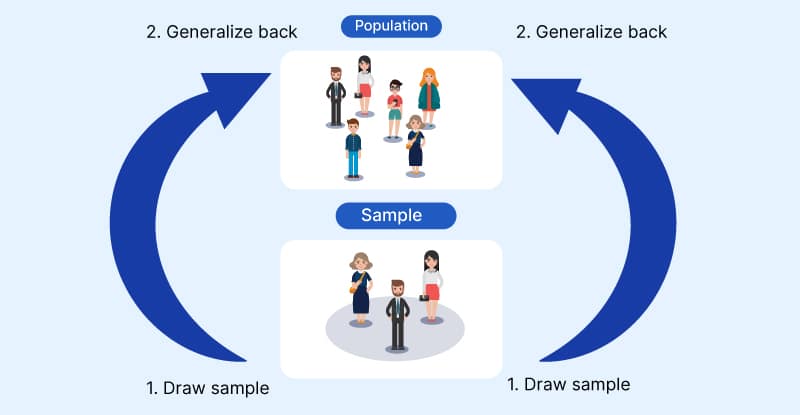Data Lake Vs Data Warehouse – What’s the Biggest Difference?
Data Lake Vs Data Warehouse – What’s the Biggest Difference? SHARE THE ARTICLE ON Table of Contents What’s the biggest difference between a data lake

Find the best survey software for you!
(Along with a checklist to compare platforms)
Take a peek at our powerful survey features to design surveys that scale discoveries.
Explore Voxco
Need to map Voxco’s features & offerings? We can help!
Find the best customer experience platform
Uncover customer pain points, analyze feedback and run successful CX programs with the best CX platform for your team.

We’ve been avid users of the Voxco platform now for over 20 years. It gives us the flexibility to routinely enhance our survey toolkit and provides our clients with a more robust dataset and story to tell their clients.
Steve Male
VP Innovation & Strategic Partnerships, The Logit Group
Explore Regional Offices

Find the best survey software for you!
(Along with a checklist to compare platforms)
Take a peek at our powerful survey features to design surveys that scale discoveries.
Explore Voxco
Need to map Voxco’s features & offerings? We can help!
Find the best customer experience platform
Uncover customer pain points, analyze feedback and run successful CX programs with the best CX platform for your team.

We’ve been avid users of the Voxco platform now for over 20 years. It gives us the flexibility to routinely enhance our survey toolkit and provides our clients with a more robust dataset and story to tell their clients.
Steve Male
VP Innovation & Strategic Partnerships, The Logit Group
Explore Regional Offices

Find the best survey software for you!
(Along with a checklist to compare platforms)
Take a peek at our powerful survey features to design surveys that scale discoveries.
Explore Voxco
Need to map Voxco’s features & offerings? We can help!
Find the best customer experience platform
Uncover customer pain points, analyze feedback and run successful CX programs with the best CX platform for your team.

We’ve been avid users of the Voxco platform now for over 20 years. It gives us the flexibility to routinely enhance our survey toolkit and provides our clients with a more robust dataset and story to tell their clients.
Steve Male
VP Innovation & Strategic Partnerships, The Logit Group
Explore Regional Offices

Transform your insight generation process
Use our in-depth online survey guide to create an actionable feedback collection survey process.
SHARE THE ARTICLE ON
External Validity refers to the extent to which the cause-and-effect relationship found between the variables in the experiment can be generalized. It reflects whether or not the findings of the study can be generalized beyond an experimental setting, to real-life situations as well.
When research is conducted, it has the objective of identifying correlations and patterns that exist in the real world and therefore aims to obtain knowledge that is generalizable. This is why external validity is important in research studies.
There are three main types of external validity, namely:
Population validity is concerned with whether the findings of your research are generalizable to people in the general population, beyond those that you have sampled in your research.
The population validity of your research is influenced by how well you’ve chosen a sample group for your experiment. It is important to select a sample that can mirror the characteristics of the target population you are trying to study. The better your sample group is in doing so, the more generalizable your results will be to the larger population.
Temporal validity is concerned with whether the findings of your research are generalizable to different periods of time, beyond the season or specific time that you conducted your experimental research. For instance, many studies conducted for the social sciences in the 1900s may have findings that don’t necessarily hold true to the population today due to the evolving social attitudes and behaviour.
Environmental validity is concerned with whether the findings of your research are generalizable to other situations and environments beyond those in which your experiment was conducted.
Controlled test environments are usually designed in a way that allows participants to provide their best performance: the environment is designed to lack any sources of confusion, distraction, or fatigue. However, in real-life settings, people may not always be in such environments and may therefore not respond the same way as they would in a controlled experiment. Therefore, highly controlled environments that are significantly different from the real world will provide research findings with low external validity that may not be generalizable to the larger population.
Let’s take a look at some of the different threats to external validity:
A sampling bias is created when units from the target population haven’t been selected appropriately due to which the sample is not representative of the population. This leads to the sample having low external validity as it is less generalizable to the population.
This effect refers to the inclination of people to work harder and perform better when they are the subjects of an experimental study. This tendency of participants changes their behaviour, making the findings of the study less generalizable to real-life settings.
This refers to the concept that treatments are more effective or less effective for different individuals as a result of their specific abilities. It’s the tenet that optimal learning results are only achieved when the instruction is matched to the aptitude of each learner.
The situation effect refers to to the different situational factors that threaten the external validity of a study. This includes the time of day, location, researcher characteristics, setting, and more: each could limit the generalizability of the research findings.
The following three tips can be used to increase the external validity of an experiment:
Carefully select a sampling technique that will be most appropriate for your study. You must select one that allows you to obtain a sample group that is reflective of the larger population being studied.
Replicating your study multiple times can help enhance the generalizability of your research findings to other time periods, environmental settings, and populations.
Field experiments are experiments that are conducted in natural and “real-word” settings rather than in a laboratory setting. Field experiments often have higher external validity than studies conducted in controlled environments as they are more generalizable due to their real-world experiment setting.
Internal validity can be defined as the extent to which a research study establishes a reliable cause-and-effect relationship between the variables in the experiment.
There are two models that can be used to describe the relationship between internal and external validity:
The relationship between internal and external validity can be described as a trade-off. This means to achieve more of one, there has to be a compromise of the other, and vice versa. This is due to the fact that internal validity is achieved through increased control whereas external validity is achieved through naturalness and representation: contradictory ideas that can’t be achieved simultaneously.
According to this model, internal validity is a purchaser of external validity. In other words, if there is no control in the experiment (internal validity), the results cannot be generalized at all (external validity).
Read more
Data Lake Vs Data Warehouse – What’s the Biggest Difference? SHARE THE ARTICLE ON Table of Contents What’s the biggest difference between a data lake

This year, we celebrate our 20th year in Paris. Our Paris office is a central hub for all of our European operations, supporting hundreds and hundreds
Understanding the Core of ANOVA Test in Research Methodology SHARE THE ARTICLE ON Table of Contents Introduction What is Research Methodology? A research methodology can

Global consultancy certifies Voxco Online “the highest market value in the industry”. The customer Frost & Sullivan is one of the fastest growing partnership firms

How Netflix’ Employee & Customer Experience has helped them grow double their expectations during the crisis Read Netflix’s secret to customer experience Get our in-depth

Product Survey Questions SHARE THE ARTICLE ON Table of Contents A product survey is a series of questions sent to a subset of our user
We use cookies in our website to give you the best browsing experience and to tailor advertising. By continuing to use our website, you give us consent to the use of cookies. Read More
| Name | Domain | Purpose | Expiry | Type |
|---|---|---|---|---|
| hubspotutk | www.voxco.com | HubSpot functional cookie. | 1 year | HTTP |
| lhc_dir_locale | amplifyreach.com | --- | 52 years | --- |
| lhc_dirclass | amplifyreach.com | --- | 52 years | --- |
| Name | Domain | Purpose | Expiry | Type |
|---|---|---|---|---|
| _fbp | www.voxco.com | Facebook Pixel advertising first-party cookie | 3 months | HTTP |
| __hstc | www.voxco.com | Hubspot marketing platform cookie. | 1 year | HTTP |
| __hssrc | www.voxco.com | Hubspot marketing platform cookie. | 52 years | HTTP |
| __hssc | www.voxco.com | Hubspot marketing platform cookie. | Session | HTTP |
| Name | Domain | Purpose | Expiry | Type |
|---|---|---|---|---|
| _gid | www.voxco.com | Google Universal Analytics short-time unique user tracking identifier. | 1 days | HTTP |
| MUID | bing.com | Microsoft User Identifier tracking cookie used by Bing Ads. | 1 year | HTTP |
| MR | bat.bing.com | Microsoft User Identifier tracking cookie used by Bing Ads. | 7 days | HTTP |
| IDE | doubleclick.net | Google advertising cookie used for user tracking and ad targeting purposes. | 2 years | HTTP |
| _vwo_uuid_v2 | www.voxco.com | Generic Visual Website Optimizer (VWO) user tracking cookie. | 1 year | HTTP |
| _vis_opt_s | www.voxco.com | Generic Visual Website Optimizer (VWO) user tracking cookie that detects if the user is new or returning to a particular campaign. | 3 months | HTTP |
| _vis_opt_test_cookie | www.voxco.com | A session (temporary) cookie used by Generic Visual Website Optimizer (VWO) to detect if the cookies are enabled on the browser of the user or not. | 52 years | HTTP |
| _ga | www.voxco.com | Google Universal Analytics long-time unique user tracking identifier. | 2 years | HTTP |
| _uetsid | www.voxco.com | Microsoft Bing Ads Universal Event Tracking (UET) tracking cookie. | 1 days | HTTP |
| vuid | vimeo.com | Vimeo tracking cookie | 2 years | HTTP |
| Name | Domain | Purpose | Expiry | Type |
|---|---|---|---|---|
| __cf_bm | hubspot.com | Generic CloudFlare functional cookie. | Session | HTTP |
| Name | Domain | Purpose | Expiry | Type |
|---|---|---|---|---|
| _gcl_au | www.voxco.com | --- | 3 months | --- |
| _gat_gtag_UA_3262734_1 | www.voxco.com | --- | Session | --- |
| _clck | www.voxco.com | --- | 1 year | --- |
| _ga_HNFQQ528PZ | www.voxco.com | --- | 2 years | --- |
| _clsk | www.voxco.com | --- | 1 days | --- |
| visitor_id18452 | pardot.com | --- | 10 years | --- |
| visitor_id18452-hash | pardot.com | --- | 10 years | --- |
| lpv18452 | pi.pardot.com | --- | Session | --- |
| lhc_per | www.voxco.com | --- | 6 months | --- |
| _uetvid | www.voxco.com | --- | 1 year | --- |